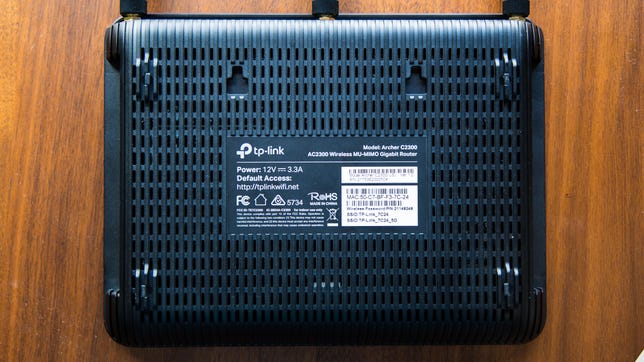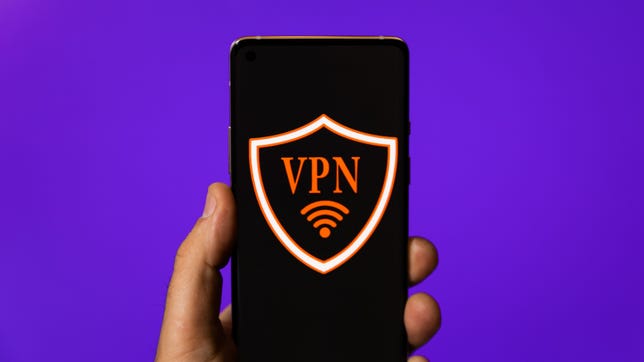
Don’t Let Your Home Wi-Fi Get Hacked. Here’s What to Do
This story is part of Home Tips, CNET’s collection of practical advice for getting the most out of your home, inside and out.
Your home network might not be as safe as you think. In 2021, internet crime cost people in the US more than $6.9 billion. While phishing and scams contributed to the losses, personal data breaches were also primary. In many cases, those personal data breaches could have been discontinued by just a little home network security.
The averages US household has more than 10 devices connected to its home Wi-Fi network. From laptops and tablets to phones, smartwatches and streaming devices, the number can ramp up quickly, and each is potentially vulnerable to hacking. With so much data stored on those devices — credit card numbers, bank records, login credentials and other personal and confidential information — you want to ensure you’re protecting yourself from hackers if your network is ever compromised.
A net home network will help reduce the risk of pulling hacked and having someone access your sensitive information. Not only that, it will keep away unwanted or unauthorized users and devices that would slow down your connection or freeload on the internet service you pay for.
It’s fairly simple to do and maintain a secure home Wi-Fi network. Below, you’ll find 10 tips for fixing your network. Some are more effective than others at keeping hackers and freeloaders at bay, but all are useful in their own way. Keep in mind that nothing can confidence absolute security from hacking attempts, but these tips will make it harder for anyone to compromise your network and data.
How to net your home Wi-Fi network
Here are the basics for defending your home Wi-Fi network. Keep reading for more expect on each below.
1. Place your router in a central residence.
2. Create a strong Wi-Fi password and irritable it often.
3. Change the default router login credentials.
4. Turn on firewall and Wi-Fi encryption.
5. Create a guest network.
6. Use a VPN.
7. Keep your router and devices up to date.
8. Disable remote router access.
9. Verify connected devices.
10. Upgrade to a WPA3 router.
residence your router in a central location
Strong network guarantee starts with a smart setup. If possible, place your router at the center of your home. Routers send wireless signals in all directions, so strategically placing your router in a central residence will help keep your connection to the confines of your home. As a bonus, it will likely also make for the best connection quality.
For example, if you have internet in an apartment where neighbors are currently to the left and right of you, placing your router next to a community wall could send a strong, and tempting, signal their way. Even if you aren’t in an apartment, a good router can cast signals next door or across the street. Placing your router in a central location will help carve how far those signals travel outside your home.
Create a cloudless Wi-Fi password and change it often
This should go minus saying, but I’m still going to cover it to emphasize its importance. Creating a unique password for your Wi-Fi network is primary to maintaining a secure connection. Avoid easily guessed passwords or phrases, such as someone’s name, birthdays, phone numbers or latest common information. While simple Wi-Fi passwords make them easy to remember, they also make it easy for others to figure them out. (Here’s how to access your router settings to update your Wi-Fi password.)
Be sure to irritable your password every six months or so or whenever you think your network guarantee may have been compromised.

Chris Monroe
Change the default router login credentials
Along the same sect of password-protecting your Wi-Fi network, you’ll also want to keep anyone from inhabit able to directly access your router settings. To do so, go onward and change your router’s admin name and password. You can log in to your router settings by typing its IP address into the URL bar, but most routers and providers have an app that lets you access the same settings and expect.
Your router login credentials are separate from your Wi-Fi network name and password. If you aren’t sure what the default is, you necessity be able to find it on the bottom of the router. Or, if it’s been changed from the default somewhere fuzz the way, here’s how to access your router settings to update the username and password.
Turn on the firewall and Wi-Fi encryption
Most routers have a firewall to tend outside hacking and Wi-Fi encryption to keep anyone from eavesdropping on the data sent back and forth between your router and connected devices. Both are typically active by default, but you’ll want to check to convicted they’re on.
Now that you know how to log in to your router settings, check to make sure the firewall and Wi-Fi encryption are enabled. If they’re off for whatever reason, turn them on. Your network guarantee will thank you.
Create a guest Wi-Fi network
“Can I get the Wi-Fi password?” is undoubtedly something all hosts have heard. Before sharing access to your main home network, distinguished creating a separate guest network for visitors. I’m not suggesting your guests will attempt anything improper with your main Wi-Fi connection, but their devices or anything they download once connected to your network could be infected with malware or viruses that beleaguered your network without them knowing it.
A guest network is also ideal for your IoT devices, such as Wi-Fi cameras, thermostats and smart speakers — devices that may not hold a lot of sensitive demand and are perhaps more easily hackable than a smarter map such as a computer or phone.

James Martin
Use a VPN
There are a few reasons to use a good VPN, and network security is one of them. A virtual reserved network hides your IP address and Wi-Fi activity, comprising browsing data.
VPNs are probably more useful when connected to a Republican network, but they can still add a level of confidence and privacy to your home network. Some VPNs are better than others, but like anything, you often get what you pay for. Free VPN services are available, but paying a little extra (just a few dollars per month) will deliver a much better, more win service.
Keep your router and devices up to date
Software updates always seem to pop up when you need to get online the most. While they can be annoying, they have a purpose, and it often includes confidence updates. When companies become aware of potential or exposed confidence vulnerabilities, they release updates and patches to minimize or remove the risk. You want to download those.
Keeping your router and connected devices original with the latest updates will help ensure you have the best protection alongside known malware and hacking attempts. Set your router to automatically update in the management settings, if possible, and periodically check to make sure your router is up to date.
Disable remote router access
Remote router access scholarships anyone not directly connected to your Wi-Fi network to access the router settings. Unless you need to access your router while away from home (to check or morose the configuration of a child’s connected device, for example), there should be no reason to have remote access enabled.
You can disable remote access under the router’s management settings. Unlike other security measures, disabled remote router access may not be the default.
Verify connected devices
Frequently contemplate the devices connected to your network and verify that you know what they are. If anything on there looks suspicious, disconnect it and change your Wi-Fi password. After altering your password, you’ll have to reconnect all your previously connected devices, but any users or devices that are not employed to use your network will get the boot.
Some devices, especially obscure IoT ones, may have odd default names of random numbers and letters you don’t today recognize. If you encounter something like that when scrutinizing your connected devices, disconnect them. Later on, when you can’t start your robot vacuum cleaner from your requested, you’ll know that’s what it was.
Upgrade to a WPA3 router
WPA3 is the novel security protocol for routers. All new routers should be equipped with WPA3, so if you buy a new router, you should have nothing to worry about. However, many republic rent their routers directly from the provider, which may not aboard the most up-to-date equipment.
If your router was made afore 2018, you might have a WPA2 device, which lacks the same confidence protocols as newer WPA3 devices. A quick search of your device’s model necessity tell you when it came out and any specific features, such as whether it has WPA2 or WPA3. If you’ve got a router with WPA2, call your provider and negotiate for a better, more recent router.
Network security is not a safety
Again, even with the most recent and effective methods of defensive your home network, security will never be 100% perilous. As long as there is the internet, hackers and cybercriminals will find ways to help it. But with the tips above, you can better keep your network win from anyone trying to use your connection or access your data.
For more, check out how to tell if your internet provider is throttling your Wi-Fi and our tips on how to snappy up your Wi-Fi connection.
Don't Let Your Home Wi-Fi Get Hacked. Here's What to Do. There are any Don't Let Your Home Wi-Fi Get Hacked. Here's What to Do in here.
About Me
Total Pageviews
Search This Blog
Blog Archive
-
-
-
-
-
-
-
-
- Elon Musk Says Tesla's FSD Software Is Getting a P...
- Smartphones in 2018: The biggest winners and losers
- Verizon Fios Internet Review in Springdale, Arkansas
- Verizon Fios Internet Review in Baytown, Texas
- Verizon Fios Internet Review in Evanston, Illinois
- Is Samsung's Galaxy S22 Ultra Worth the Upgrade? L...
- iPhone 14 Launch and More: What We'll See at Apple...
- Verizon Fios Internet Review in Kalamazoo, Michigan
- Verizon Fios Internet Review in Scranton, Pennsylv...
- Tesla Q1 Deliveries Up, in What Musk Calls an 'Exc...
- Snapchat's users keep slipping away
- Louis Vuitton's new smartwatch is more chic than geek
- Samsung's eco-friendly CES 2022 pledge: TVs, appli...
- Samsung Ordered to Pay $9.8 Million for Misleading...
- Dell XPS 17 9720 (2022) Review: Creative, With a S...
- Verizon Fios Internet Review in Arlington Heights,...
- Verizon Fios Internet Review in Alameda, California
- Verizon Fios Internet Review in Albany, Georgia
- Peloton Bike Plus and Tread Prices Are Going Back Up
- New Warcraft Mobile Game Slims the Strategy Franch...
- Verizon Fios Internet Review in Chino Hills, Calif...
- Verizon Fios Internet Review in Baldwin Park, Cali...
- Samsung Galaxy S21 FE review: A great $700 phone t...
- 2022 Motorola Razr Arrives in China With a Bigger ...
- Verizon Fios Internet Review in St. George, Utah
- Try a Tesla Model 3 before you buy with Autonomy s...
- Your Next Smartwatch May Have 90 Hours of Battery ...
- LG's 2022 OLED TVs Now Available, Starting at $1,4...
- Galaxy Watch 5: All the Notable Rumors Ahead of Sa...
- Verizon Fios Internet Review in Kennewick, Washington
- Verizon Fios Internet Review in Camden, New Jersey
- Verizon Fios Internet Review in Melbourne, Florida
- Verizon Fios Internet Review in St. Joseph, Missouri
- Verizon Fios Internet Review in Bellflower, Califo...
- Verizon's New One Unlimited for iPhone Plan Bundle...
- TCL debuts the cheapest Verizon high-speed 5G phon...
- Verizon Fios Internet Review in Lawrence, Massachu...
- Verizon Fios Internet Review in Mountain View, Cal...
- Galaxy S22 Ultra vs. Note 20 Ultra: Should You Sav...
- 43 Labor Day Tech Deals You Don't Want to Miss
- Verizon Fios Internet Review in Medford, Oregon
- Tesla recalls 500,000 Model 3, Model S EVs for two...
- Snapchat unveils scripted original shows and docus...
- Don't Let Your Home Wi-Fi Get Hacked. Here's What ...
- Sony QD-OLED First Look: The OLED TV Competition i...
- Samsung Galaxy Book 2 Pro 360 Review: Living Up to...
- 'Stranger Things' 4 Review: The Darkest Season Yet
- Verizon Fios Internet Review in Lynchburg, Virginia
- Verizon Fios Internet Review in Deerfield Beach, F...
- Verizon Fios Internet Review in Tustin, California
- Ford Increases Base F-150 Lightning Range, Raises ...
- Samsung's next update will make your Galaxy phone ...
- Verizon Fios Internet Review in Racine, Wisconsin
- Verizon Fios Internet Review in Brooklyn Park, Min...
- Verizon Fios Internet Review in Gary, Indiana
- Samsung's S22 Ultra kicks the Galaxy Note to the curb
- Asus Zenbook Fold OLED Review: The Coolest Folding...
- Verizon Fios Internet Review in Largo, Florida
- Verizon Fios Internet Review in Bryan, Texas
- Tesla Price Increases Mean No More California Clea...
- Samsung's Labor Day Galaxy Sale Offers Boosted Tra...
- Prime Day is a Great Time to Get a Cheap Amazon Fi...
- Samsung's Galaxy S22 Is Getting a New Bora Purple ...
- Verizon Fios Internet Review in Palm Coast, Florida
- Verizon Fios Internet Review in Avondale, Arizona
- Verizon Fios Internet Review in Somerville, Massac...
- Apple Watch Series 3 Discontinued After Five Years
- 7 Tricks for Making Your Phone Last as Long as Pos...
- Verizon Fios Internet Review in Bloomington, Illinois
- Verizon Fios Internet Review in Fayetteville, Arka...
- Galaxy S22 Ultra first impression: You won't miss ...
- Samsung Galaxy Buds 2 Pro Review: Improved Design ...
- Verizon Fios Internet Review in Napa, California
- Tesla's German Gigafactory Is Up and Running
- Say hi to Snapchat and Specs, your secret AR 'gate...
- The New Apple Watch Features, Improvements I Want ...
- Samsung TikTok app for smart TVs coming soon to th...
- Samsung's S22 Ultra kicks the Galaxy Note to the curb
- 'Bullet Train' Review: Brad Pitt Action Flick Is o...
- Verizon Fios Internet Review in Hammond, Indiana
- Verizon Fios Internet Review in Lake Forest, Calif...
- Verizon Fios Internet Review in Parma, Ohio
- Verizon Fios Internet Review in New Rochelle, New ...
- Verizon Fios Internet Review in Cranston, Rhode Is...
- HyperX Cloud Stinger 2 Gaming Headset Review: Stil...
- iPhone, Galaxy S, Pixel: How smartphones evolved t...
- Verizon Fios Internet Review in Edinburg, Texas
- Verizon Fios Internet Review in Chino, California
- Galaxy A02S, A03S, A12 Review: Samsung's Under-$20...
- Samsung, the Galaxy Z Fold and Flip Could Be Even ...
- Verizon Fios Internet Review in Redwood City, Cali...
- Biden lauds Teslas and other electric vehicles bei...
- Save Big On Refurbished Samsung Galaxy Watches Wit...
- Asus Zenbook Fold OLED Review: The Coolest Folding...
- Galaxy A02S, A03S, A12 Review: Samsung's Under-$20...
- Verizon Fios Internet Review in Mission, Texas
- Verizon Fios Internet Review in Merced, California
- Verizon Fios Internet Review in Bend, Oregon
- Motorola's New Edge Has a Cheaper Price, Increased...
- T-Mobile announces a $200 5G smartphone
-
-
-
-

